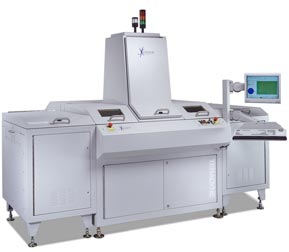2005 Articles
Teradyne’s 3-D X-Ray Inspection System
Offers off-center tomosynthesis and a static wide-angle x-ray, for improved images.
About 35 to 40% of all joints coming off an assembly line bond a BGA to a PCB. Research suggests that by 2007, area-array packaging will hide more than 50% of all solder joints produced. Combine the growing loss of visual and electrical access with the difficulties associated with detecting lead-free solder voids on dense double-sided boards, and the inspection problem only worsens. If ignored, the circuit-to-PCB assembly industry can expect significant quality degradation due to higher false-call rates and restricted defect coverage.
 The MX-Station automatically calculates z-axis information, eliminating the need to pre-map the PCB surface and architecture. |
Enter ClearVue and a new 3-D x-ray technology and automated inspection system built by Teradyne to eliminate visual interference, simplify the imaging technique and create more definitive, useful pictures. Most automated x-ray inspection (AXI) systems deployed today use laminography, a mechanically complex imaging system that moves a steerable x-ray beam in synchronization with a moving image detector (x,y) and PCB (z-axis). Laminography images lack clarity and contribute to false and/or missed failures. The new MX Station uses a patented technique based on an off-center tomosynthesis method. It uses a static ultrawide-angle x-ray source and a large, stationary detector. Only the board moves and stops in precise sections to maximize the source field of view. Image clarity is improved such that false failures below 500 joints per million inspected can be achieved with expanded defect coverage.
How It Works
A single ClearVue image acquires eight off-axis angular images (up to 40° off center) of any region of the PCB as it passes in sections through the focal plane. After multiple sectional images are taken, they are recombined in software where algorithms work to produce high resolution image slices and detect defects. The area scanned by one image measures 2.2 in2 (56 mm2). The MX system can inspect 6 in2 per second, rivaling the speed of AOI systems.
Instead of averaging the values from angled views, the method used by laminography, ClearVue selects the high and low points within the field of view and uses these as the anchors for its dynamic range, which is divided into 4,096 gray levels. The source detector can range from 0.75" to more than 2" FOV with resolution retained at 10 to 25 µm per pixel. This is sufficiently accurate to detect fine-pitch components and all common area array packages.
The beauty is its mechanical simplicity. The system is not resolution-limited by moving assemblies and mathematical averaging. And because it automatically calculates z-axis information, the need to pre-map a PCB’s surface and architecture is eliminated. This approach makes XStation faster than most laminography systems, since the multiple images required to obtain an unobstructed view of each solder joint are now captured simultaneously. Add the elimination of laser mapping and mechanical movements and it is feasible to operate the XStation MX inline at production beat rates.
The station comes equipped with user productivity tools in the form of programming and analysis software designed to ease AXI development costs and help the ramp to inline quality control. Included is XFrame, a fully integrated PC-based program development environment. It permits all programming to be performed offline, enabling maximum equipment utilization. Also included is XStat, a statistical process and control module that provides real-time and offline reporting of defect and false call data compiled by XVer, a repair verification tool that facilitates fault diagnosis by providing graphical CAD-based views and x-ray images of failed regions. MX users may also import Teradyne’s Strategist software as a tool-guide to help manufacturers’ integrate AXI in their inline test floor.
The MX can load/unload boards measuring up to 20 x 18" (508 x 457 mm) or a little as 2 in2 in 5 sec. (avg). It inspects up to 50,000 solder joints. Its footprint is 120 x 109" and weight is roughly 4,500 lbs. Additional air and power requirements are 100 to 200 psi compressed and 208 VAC to 230 VAC (single phase 30A), respectively.




